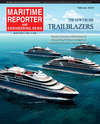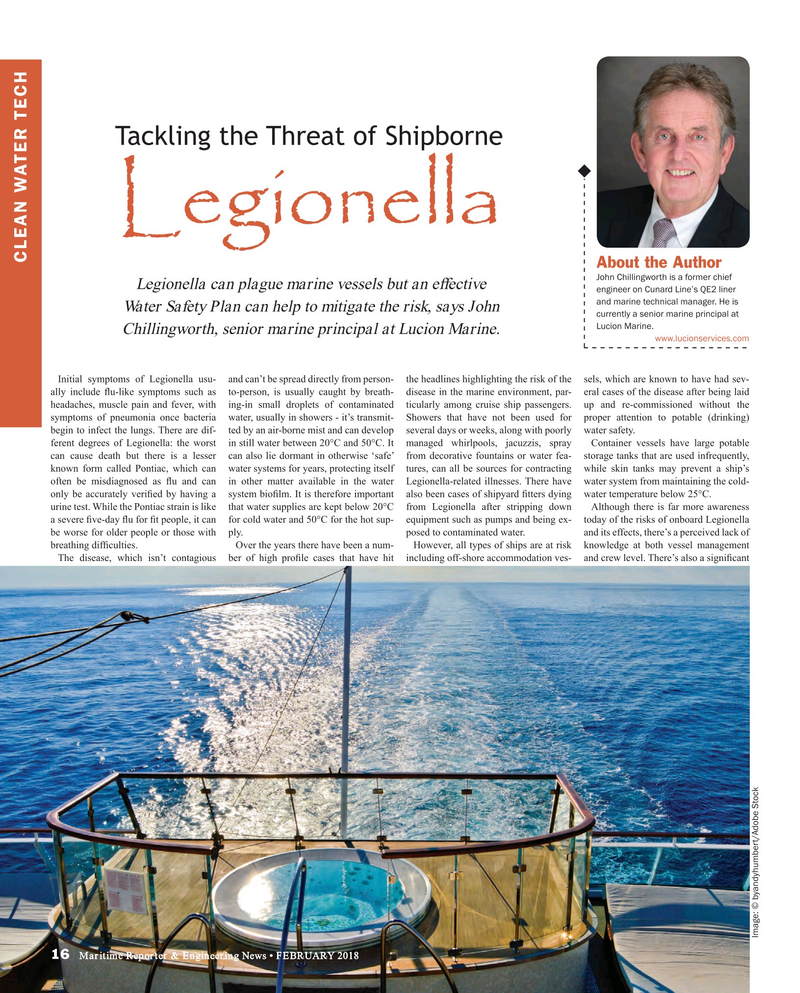
Page 16: of Maritime Reporter Magazine (February 2018)
Cruise Ship Annual
Read this page in Pdf, Flash or Html5 edition of February 2018 Maritime Reporter Magazine
Tackling the Threat of Shipborne
Legionella
CLEAN WATER TECH
About the Author
John Chillingworth is a former chief
Legionella can plague marine vessels but an effective engineer on Cunard Line’s QE2 liner and marine technical manager. He is
Water Safety Plan can help to mitigate the risk, says John currently a senior marine principal at
Lucion Marine.
Chillingworth, senior marine principal at Lucion Marine.
www.lucionservices.com
Initial symptoms of Legionella usu- and can’t be spread directly from person- the headlines highlighting the risk of the sels, which are known to have had sev- ally include ? u-like symptoms such as to-person, is usually caught by breath- disease in the marine environment, par- eral cases of the disease after being laid headaches, muscle pain and fever, with ing-in small droplets of contaminated ticularly among cruise ship passengers. up and re-commissioned without the symptoms of pneumonia once bacteria water, usually in showers - it’s transmit- Showers that have not been used for proper attention to potable (drinking) begin to infect the lungs. There are dif- ted by an air-borne mist and can develop several days or weeks, along with poorly water safety. ferent degrees of Legionella: the worst in still water between 20°C and 50°C. It managed whirlpools, jacuzzis, spray Container vessels have large potable can cause death but there is a lesser can also lie dormant in otherwise ‘safe’ from decorative fountains or water fea- storage tanks that are used infrequently, known form called Pontiac, which can water systems for years, protecting itself tures, can all be sources for contracting while skin tanks may prevent a ship’s often be misdiagnosed as ? u and can in other matter available in the water Legionella-related illnesses. There have water system from maintaining the cold- only be accurately veri? ed by having a system bio? lm. It is therefore important also been cases of shipyard ? tters dying water temperature below 25°C. urine test. While the Pontiac strain is like that water supplies are kept below 20°C from Legionella after stripping down Although there is far more awareness a severe ? ve-day ? u for ? t people, it can for cold water and 50°C for the hot sup- equipment such as pumps and being ex- today of the risks of onboard Legionella be worse for older people or those with ply. posed to contaminated water. and its effects, there’s a perceived lack of breathing dif? culties. Over the years there have been a num- However, all types of ships are at risk knowledge at both vessel management
The disease, which isn’t contagious ber of high pro? le cases that have hit including off-shore accommodation ves- and crew level. There’s also a signi? cant
Image: © byandyhumbert/Adobe Stock 16 Maritime Reporter & Engineering News • FEBRUARY 2018
MR #2 (10-17).indd 16 MR #2 (10-17).indd 16 2/8/2018 9:40:20 AM2/8/2018 9:40:20 AM

 15
15

 17
17
